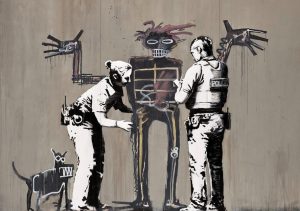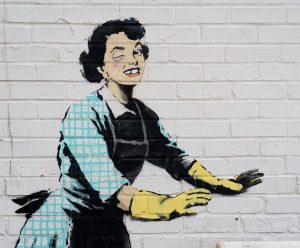USD 2,690,000
Source: Sotheby’s
‘The vandalized paintings reflect life as it is now.
We don’t live in a world like Constable’s Haywain anymore and, if you do, there is probably a travelers’ camp on the other side of the hill.
The real damage done to our environment is not done by graffiti writers and drunken teenagers, but by big business…’

Distilling his signature criticality of society’s predilections into a lush pastoral scene and stenciled deadpan phrase, This is not a photo opportunity demonstrates the enduring prescience of Banksy’s practice. Part of his Vandalized Oils series, the present work juxtaposes contemporary graffiti and stenciling with the archetypal painted landscape. Disrupting art historical convention, the piece also sees a Duchampian appropriation, with a found painting serving as the basis for Banksy’s mocking chide. Created several years before the formation of social media platforms such as Instagram, This is not a photo opportunity has increased resonance today, as the taking and sharing of photos has become a pivotal part of the formation of contemporary identity.

IMAGE © THE METROPOLITAN MUSEUM OF ART, NEW YORK / ART RESOURCE, NY
Nestled within a gilded frame, the present work sees a quaint and slightly saccharine rural landscape lovingly rendered by the since-forgotten “Randall,” whose signature is readily legible in the lower right corner of the work. Superimposed over this John Constable-inspired idyll is Banksy’s rebuke, sprayed in white across the canvas: “This is not a photo opportunity.” This phrase has been used many times in Banksy’s urban interventions over the years, on the South Bank of the Thames opposite the Houses of Parliament, or at a viewpoint overlooking the Eiffel Tower in Paris. Indeed, Martin Bull’s monograph on the artist’s most notable street artworks shares the title of the present work, attesting to its emblematic importance.

This is not a photo opportunity fulfills its critical capacity through several interventions into art history itself. Part of a larger series in which Banksy modifies ornately framed paintings found at thrift stores around London, often consisting of lowbrow replications of canonized paintings by the likes of Monet, Van Gogh and Warhol, the present work typifies the artist’s ongoing project. Subverting the essence of these masters’ work, Monet’s lily pond at Giverny is filled with abandoned shopping carts, Van Gogh’s lively sunflowers are hopelessly wilted, Warhol’s can of tomato soup morphs from a Campbell’s into a Tesco Value. This is a series that unites both the artist’s studio and public practice. Over the years, Bansky has installed defaced paintings in the Louvre, the Metropolitan Museum of art and beyond, demonstrating a brand of irreverence towards the traditional bastions of the artworld perhaps best reflected in the live shredding of his own painting in the Sotheby’s saleroom in 2018.

 JOHN BALDESSARI, WHAT IS PAINTING, 1966-68
JOHN BALDESSARI, WHAT IS PAINTING, 1966-68IMAGE © THE MUSEUM OF MODERN ART/LICENSED BY SCALA / ART RESOURCE, NY. ART © JOHN BALDESSARI 1966–68. COURTESY ESTATE OF JOHN BALDESSARI © 2022
Banksy has long been outspoken about commodification, consumerism and humanity’s abuse of the environment. In the present work, this is reflected through a marriage of cautionary text and images of places we are conditioned to mindlessly photograph. In asserting that these places are not photo opportunities, the artist is confronting the viewer and their priorities. The artist notes: “The vandalized paintings reflect life as it is now. We don’t live in a world like Constable’s Haywain anymore and, if you do, there is probably a travelers’ camp on the other side of the hill. The real damage done to our environment is not done by graffiti writers and drunken teenagers, but by big business… exactly the people who put gold-framed pictures of landscapes on their walls and try to tell the rest of us how to behave.” (Banksy quoted in: Channel 4 News, 13 October 2005)

RIGHT: MARCEL DUCHAMP, L.H.O.O.Q. MONA LISA. 1919. IMAGE © CNAC/MNAM, DIST. RMN-GRAND PALAIS / ART RESOURCE, NY. ART © ASSOCIATION MARCEL DUCHAMP / ADAGP, PARIS / ARTISTS RIGHTS SOCIETY (ARS), NEW YORK 2022
Galvanized by social, political and environmental consciousness and armed with satirical prowess, This is not a photo opportunity is a layered conflation of Banksy’s public performance and studio work. Borrowing from Dadaist traditions, it is through appropriation — here commanding verbiage placed overtop a ready-made painting — that This is not a photo opportunity critiques society’s predilection for photographing, rather than working to preserve, areas prone to rapid disappearance. The prescience of this painting is furthered by the rising use of social media, wherein aesthetics, rather than actions, are of utmost importance. Indeed, This is not a photo opportunity embodies Banksy’s singular ability to contemplate social issues through an unlikely union of humor and history.





